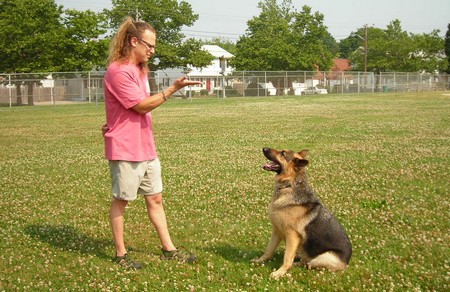Most puppies will happily approach virtually anyone, whether called or not; that is, until they collide with adolescence and develop other more important doggy interests, such as sniffing a multiplicity of exquisite odors on the grass. Your mission, Mr. and/or Ms. Owner, is to teach and reward the pup for coming reliably, willingly and happily when called¡ªand you have just three months to get it done. Unless adequately reinforced, your puppy’s tendency to approach people will self-destruct by adolescence.
Gall your dog (“Fido, come!”), open your arms (and maybe squat down) as a welcoming signal, waggle a treat or toy as a lure, and reward the puppydog when he comes running. Do not wait to praise the dog until he reaches you¡ªhe may come 95 percent of the way and then run off after some distraction. Instead, praise the dog’s first step towards you and continue praising enthusiastically for every step he takes in your direction.

When the rapidly approaching puppy dog is three lengths away from impact, instruct him to sit (“Fido, sit!”) and hold the lure in front of you in an outstretched hand to prevent him from hitting you mid-chest and knocking you flat on your back! As Fido decelerates to nose the lure, move the treat upwards and backwards just over his muzzle with an upwards motion of your extended arm (palm-upwards). As the dog looks up to follow the lure, he will sit down (if he jumps up, you are holding the lure too high). Praise the dog for sitting. Move backwards and call him again. Repeat this many times over, always praising when Fido comes and sits; on occasion, reward him.
For the first couple of trials, use a training treat both as a lure to entice the dog to come and sit and as a reward for doing so. Thereafter, try to use different items as lures and rewards. For example, lure the dog with a Kong or Frisbee but reward her with a food treat. Or lure the dog with a food treat but pat her and throw a tennis ball as a reward. After just a few repetitions, dispense with the lures and rewards; the dog will begin to respond willingly to your verbal requests and hand signals just for the prospect of praise from your heart and affection from your hands.
Instruct every family member, friend and visitor how to get the dog to come and sit. Invite people over for a series of pooch parties; do not keep the pup a secret¡ª let other people enjoy this puppy, and let the pup enjoy other people. Puppydog parties are not only fun, they easily attract a lot of people to help you train your dog. Unless you teach your dog how to meet people, that is, to sit for greetings, no doubt the dog will resort to jumping up. Then you and the visitors will get annoyed, and the dog will be punished. This is not fair. Send out those invitations for puppy parties and teach your dog to be mannerly and socially acceptable.
Even though your dog quickly masters obedient recalls in the house, his reliability may falter when playing in the back yard or local park. Ironically, it is the owner who has unintentionally trained the dog not to respond in these instances. By allowing the dog to play and run around and otherwise have a good time, but then to call the dog to put him on leash to take him home, the dog quickly learns playing is fun but training is a drag. Thus, playing in the park becomes a severe distraction, which works against training. Bad news!
Instead, whether playing with the dog off leash or on leash, request him to come at frequent intervals¡ª say, every minute or so. On most occasions, praise and pet the dog for a few seconds while he is sitting, then tell him to go play again. For especially fast recalls, offer a couple of training treats and take the time to praise and pet the dog enthusiastically before releasing him. The dog will learn that coming when called is not necessarily the end of the play session, and neither is it the end of the world; rather, it signals an enjoyable, quality time-out with the owner before resuming play once more. In fact, playing in the park now becomes a very effective life-reward, which works to facilitate training by reinforcing each obedient and timely recall. Good news!
Further Readings: